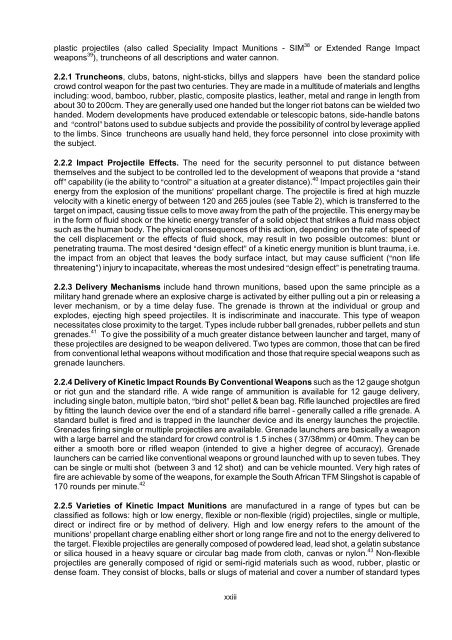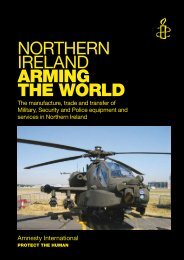CROWD CONTROL TECHNOLOGIES - Omega Research Foundation
CROWD CONTROL TECHNOLOGIES - Omega Research Foundation
CROWD CONTROL TECHNOLOGIES - Omega Research Foundation
You also want an ePaper? Increase the reach of your titles
YUMPU automatically turns print PDFs into web optimized ePapers that Google loves.
plastic projectiles (also called Speciality Impact Munitions - SIM 38 or Extended Range Impact<br />
weapons 39 ), truncheons of all descriptions and water cannon.<br />
2.2.1 Truncheons, clubs, batons, night-sticks, billys and slappers have been the standard police<br />
crowd control weapon for the past two centuries. They are made in a multitude of materials and lengths<br />
including: wood, bamboo, rubber, plastic, composite plastics, leather, metal and range in length from<br />
about 30 to 200cm. They are generally used one handed but the longer riot batons can be wielded two<br />
handed. Modern developments have produced extendable or telescopic batons, side-handle batons<br />
and )control( batons used to subdue subjects and provide the possibility of control by leverage applied<br />
to the limbs. Since truncheons are usually hand held, they force personnel into close proximity with<br />
the subject.<br />
2.2.2 Impact Projectile Effects. The need for the security personnel to put distance between<br />
themselves and the subject to be controlled led to the development of weapons that provide a )stand<br />
off( capability (ie the ability to )control( a situation at a greater distance). 40 Impact projectiles gain their<br />
energy from the explosion of the munitions propellant charge. The projectile is fired at high muzzle<br />
velocity with a kinetic energy of between 120 and 265 joules (see Table 2), which is transferred to the<br />
target on impact, causing tissue cells to move away from the path of the projectile. This energy may be<br />
in the form of fluid shock or the kinetic energy transfer of a solid object that strikes a fluid mass object<br />
such as the human body. The physical consequences of this action, depending on the rate of speed of<br />
the cell displacement or the effects of fluid shock, may result in two possible outcomes: blunt or<br />
penetrating trauma. The most desired )design effect( of a kinetic energy munition is blunt trauma, i.e.<br />
the impact from an object that leaves the body surface intact, but may cause sufficient ()non life<br />
threatening() injury to incapacitate, whereas the most undesired )design effect( is penetrating trauma.<br />
2.2.3 Delivery Mechanisms include hand thrown munitions, based upon the same principle as a<br />
military hand grenade where an explosive charge is activated by either pulling out a pin or releasing a<br />
lever mechanism, or by a time delay fuse. The grenade is thrown at the individual or group and<br />
explodes, ejecting high speed projectiles. It is indiscriminate and inaccurate. This type of weapon<br />
necessitates close proximity to the target. Types include rubber ball grenades, rubber pellets and stun<br />
grenades. 41 To give the possibility of a much greater distance between launcher and target, many of<br />
these projectiles are designed to be weapon delivered. Two types are common, those that can be fired<br />
from conventional lethal weapons without modification and those that require special weapons such as<br />
grenade launchers.<br />
2.2.4 Delivery of Kinetic Impact Rounds By Conventional Weapons such as the 12 gauge shotgun<br />
or riot gun and the standard rifle. A wide range of ammunition is available for 12 gauge delivery,<br />
including single baton, multiple baton, )bird shot( pellet & bean bag. Rifle launched projectiles are fired<br />
by fitting the launch device over the end of a standard rifle barrel - generally called a rifle grenade. A<br />
standard bullet is fired and is trapped in the launcher device and its energy launches the projectile.<br />
Grenades firing single or multiple projectiles are available. Grenade launchers are basically a weapon<br />
with a large barrel and the standard for crowd control is 1.5 inches ( 37/38mm) or 40mm. They can be<br />
either a smooth bore or rifled weapon (intended to give a higher degree of accuracy). Grenade<br />
launchers can be carried like conventional weapons or ground launched with up to seven tubes. They<br />
can be single or multi shot (between 3 and 12 shot) and can be vehicle mounted. Very high rates of<br />
fire are achievable by some of the weapons, for example the South African TFM Slingshot is capable of<br />
170 rounds per minute. 42<br />
2.2.5 Varieties of Kinetic Impact Munitions are manufactured in a range of types but can be<br />
classified as follows: high or low energy, flexible or non-flexible (rigid) projectiles, single or multiple,<br />
direct or indirect fire or by method of delivery. High and low energy refers to the amount of the<br />
munitions propellant charge enabling either short or long range fire and not to the energy delivered to<br />
the target. Flexible projectiles are generally composed of powdered lead, lead shot, a gelatin substance<br />
or silica housed in a heavy square or circular bag made from cloth, canvas or nylon. 43 Non-flexible<br />
projectiles are generally composed of rigid or semi-rigid materials such as wood, rubber, plastic or<br />
dense foam. They consist of blocks, balls or slugs of material and cover a number of standard types<br />
xxiii




